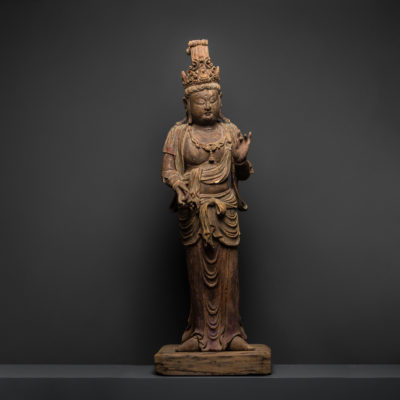
| SKU | RD.029 |
|---|---|
| Circa | 1500 AD to 1700 AD |
| Dimensions | 50″ (127cm) high x 15″ (38 cm) wide |
| Medium | Wood |
| Origin | China |
| Gallery Location | S Korea |
Guanyin is the Bodhisattva of Compassion, bodhisattva being the Sanskrit term for anyone who, motivated by great compassion, has generated a spontaneous wish to attain buddhahood for the benefit of all sentient beings. Here presented in the classic standing pose with hydbrid masculine and feminine characteristics, onto a rectangular base, the body decorated in an elegant traditional style; the deity is shown sumptuously attired wearing a neclace of beads molded from clay, the underskirt tied with a bow above the top of the overskirt which is folded over at the waist and tied with a long knotted sash that falls to the bare feet. Carved from a single piece of wood with a serene expression, his hair beneath a five-peaked Buddhist tiara containing the Amitabha Buddha, the rectangular face is stately and regal. The Guanyin, usually depicted holding symbolic objects, is here empty-handed with both hands held at waist level. The torso is thick-set and masculine, wearing a necklace of beads molded from clay. Vestments are draped over the shoulders. There is evidence that the statue has been repainted on several occasions over the years. In the past, Buddhist devotees would repair or repaint Buddhist statuary as a form of benefaction, attempting to enhance the statue in some way. There are still traces of pigment in the folds of the clothes, as well as areas of pigmentation on many places around the statue. In Buddhist temples Guanyin statues would have been placed in high, commanding positions from which worshippers could clearly see them. The statue was leaning slightly forward intentionally, so as to give the impression that is was listening carefully to the prayers offered by the worshippers below. The craftsman would have designed the statue from the perspective of those standing in the temple, from which the statue would appear to be perfectly proportioned.
Login to view price
Sign-up to receive the latest Wedding Estates news and promotions!

